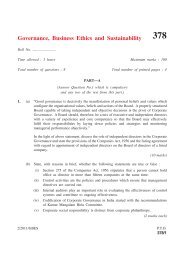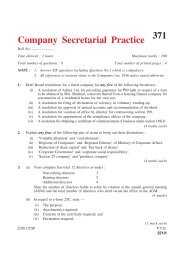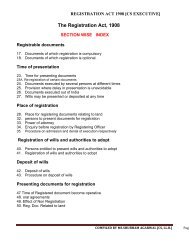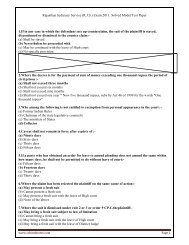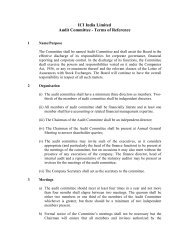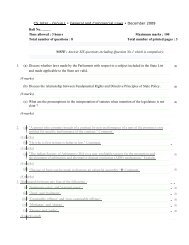CS EXECUTIVE SOLVED PAPER GCL GENERAL AND ... - cs notes
CS EXECUTIVE SOLVED PAPER GCL GENERAL AND ... - cs notes
CS EXECUTIVE SOLVED PAPER GCL GENERAL AND ... - cs notes
You also want an ePaper? Increase the reach of your titles
YUMPU automatically turns print PDFs into web optimized ePapers that Google loves.
<strong>CS</strong> <strong>EXECUTIVE</strong> <strong>SOLVED</strong> <strong>PAPER</strong><br />
<strong>GCL</strong><br />
This rule is merely a rule of construction to help the Courts to find out the true intention of<br />
the Legislature (Jage Ram v. State of Haryana, AIR 1971 SC1033). In order to make the rule<br />
applicable, the following conditions must exist:<br />
(1) The statute contains an enumeration by specific words,<br />
(2) The members of the enumeration constitute a class,<br />
(3) The class is not exhausted by the enumeration,<br />
(4) A general term follows the enumeration,<br />
(5) There is a distinct genus which comprises more than one species, and<br />
(6) There is no clearly manifested intent that the general term be given a broader meaning that<br />
the doctrine requires.<br />
Hence, we can safely conclude that "Rule of ejusdem generis is merely a rule of construction to<br />
aid the courts to find out the true intention of the legislature."<br />
Chapter - 3 : An Overview of Law Relating to Specific Relief; Arbitration and Conciliation<br />
Torts; Limitation and Evidence<br />
2010 - Dec [2] Write <strong>notes</strong> on the following :<br />
(i) Circumstantial evidence(4 marks)<br />
(ii) Appointment of experts by an arbitral tribunal under the Arbitration and Conciliation<br />
Act, 1996.(4 marks)<br />
(iii) The rule of strict liability as laid down in Rylands vs. Fletcher(4 marks)<br />
(iv) Rules relating to presumption(4 marks)<br />
Answer :<br />
(i) Circumstantial evidence is that derived from the surrounding facts. For example, if in a<br />
room, an attempt to murder has taken place, the state of the things in the room will be<br />
taken into consideration as circumstantial evidence. For although, the state of things by<br />
itself is not sufficient proof that a murder took place, but it can strongly indicate to it,<br />
through the signs of struggle in the room, the sight of blood, a weapon lying on the<br />
ground etc. In the absence of primary evidence, circumatantial or secondary evidence can<br />
be relied upon to give an idea about the situation. It cannot, however, be used by itself<br />
in murder cases.<br />
Under Section 60 of the Evidence Act of the English law, the expression "direct<br />
evidence" is not intended to exclude circumstantial evidence of things which could be<br />
seen, heard or felt. Thus, evidence whether direct or circumstantial under English law is<br />
"direct" evidence under Section 60. Before acting on circumstances put forward are<br />
satisfactorily proved and whether the proved circumstances are sufficient to bring the<br />
guilt to the accused the Court should not view in isolation the circumstantial evidence<br />
but it must take an overall view of the matter.<br />
Keep visiting www.<strong>cs</strong>hindi<strong>notes</strong>.com Page 3


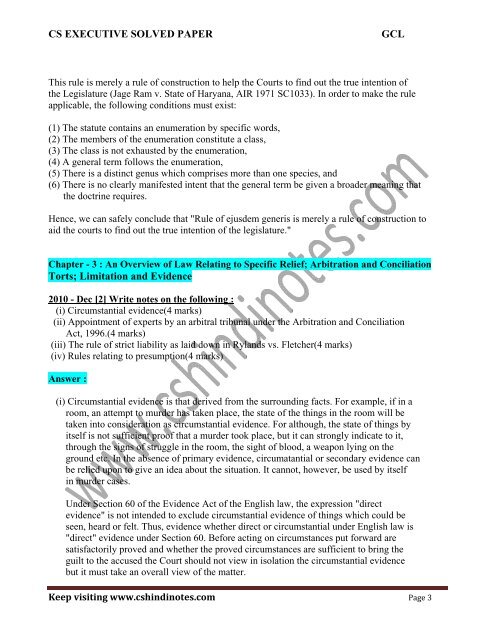
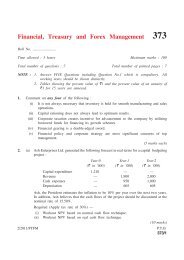

![vf/kfu;e dk vFkZ 'fu.kZ;' [ Interpretation of Statues ] Statue ... - cs notes](https://img.yumpu.com/38855798/1/190x245/vf-kfue-dk-vfkz-fukz-interpretation-of-statues-statue-cs-notes.jpg?quality=85)
